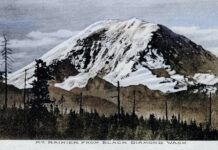Coal mining was dirty work. The face of Barry Kombol looks forward as he operates an electric trolley at the Rogers No. 3 mine in Ravensdale. At the time of this April 1974 photo, Kombol was a 23-year-old college graduate, and soon to be married. A year later, he enrolled at the University of Puget Sound where he earned a law degree. In 1978, Kombol opened an office in Black Diamond where he practiced law for over 40 years. But while working 800-feet below the earth’s surface at the last underground coal mine in Washington state, Kombol learned mining techniques from seasoned miners, most of whom had performed those jobs their entire lives.
The trolley motor Kombol was handling pulled four to six coal cars along rail tracks to and from the working face and the bottom of the mine. There, rail cars filled with five tons of coal were hoisted up the slope by a thick steel cable and unloaded at the tipple. The coal was initially sorted over a picking table with rock thrown away and raw coal sent to Black Diamond for further processing. At the time, most production from this Palmer Coking Coal mine was used to heat state prisons, primarily the Monroe Reformatory and Shelton Correction Center. The Rogers No. 3 mine closed permanently on Dec. 17, 1975, days shy of Barry’s 25th birthday.






